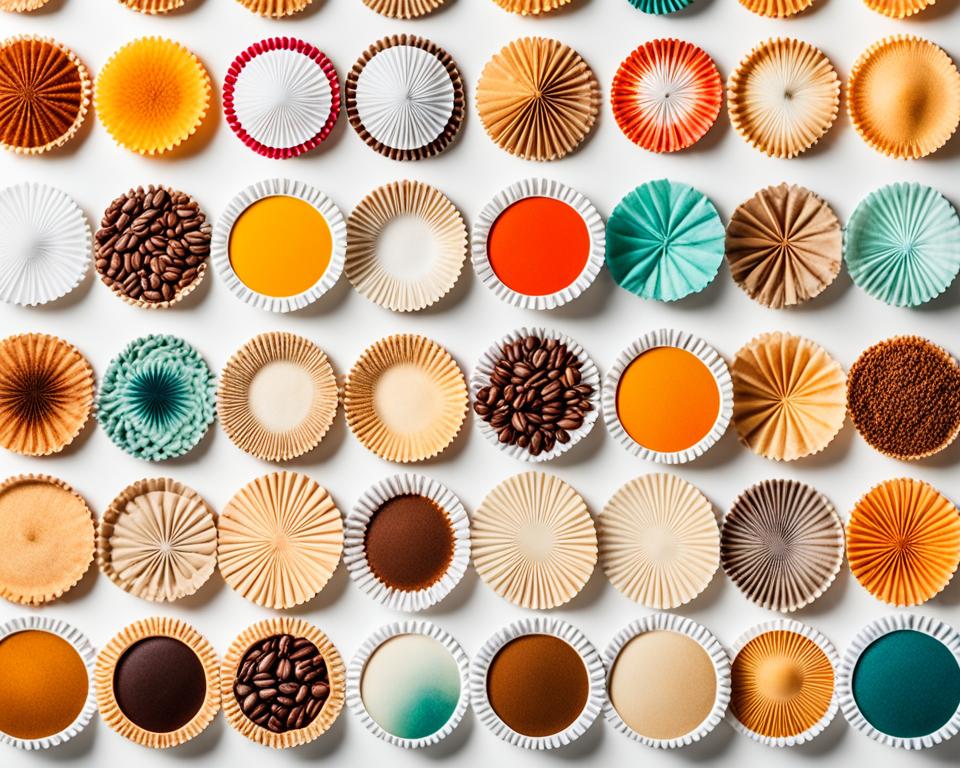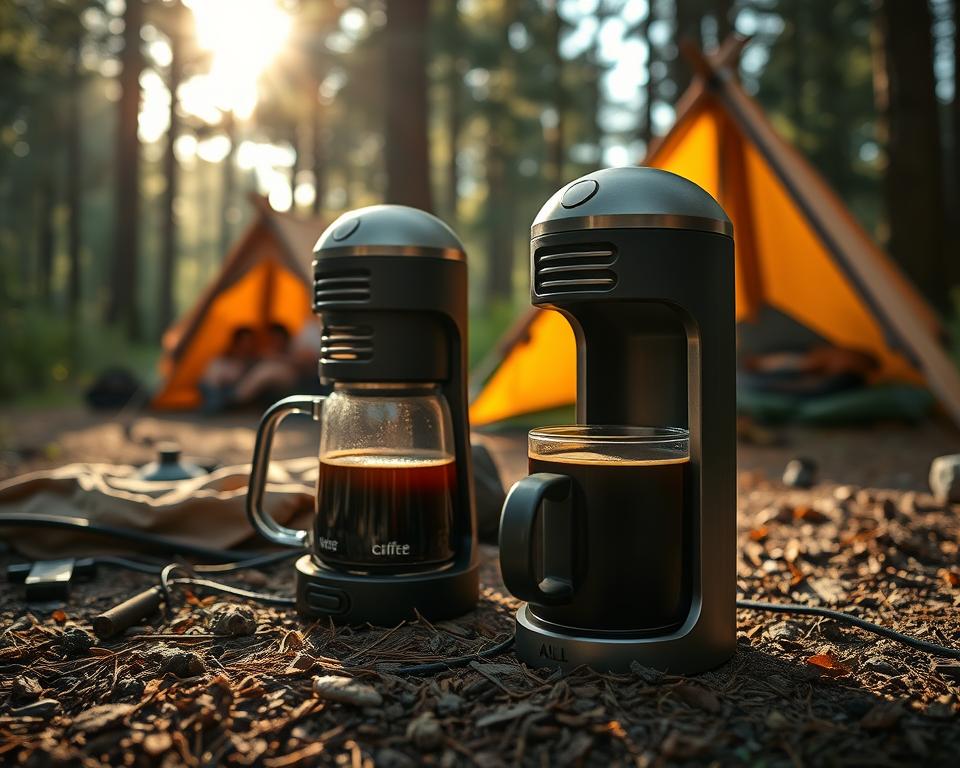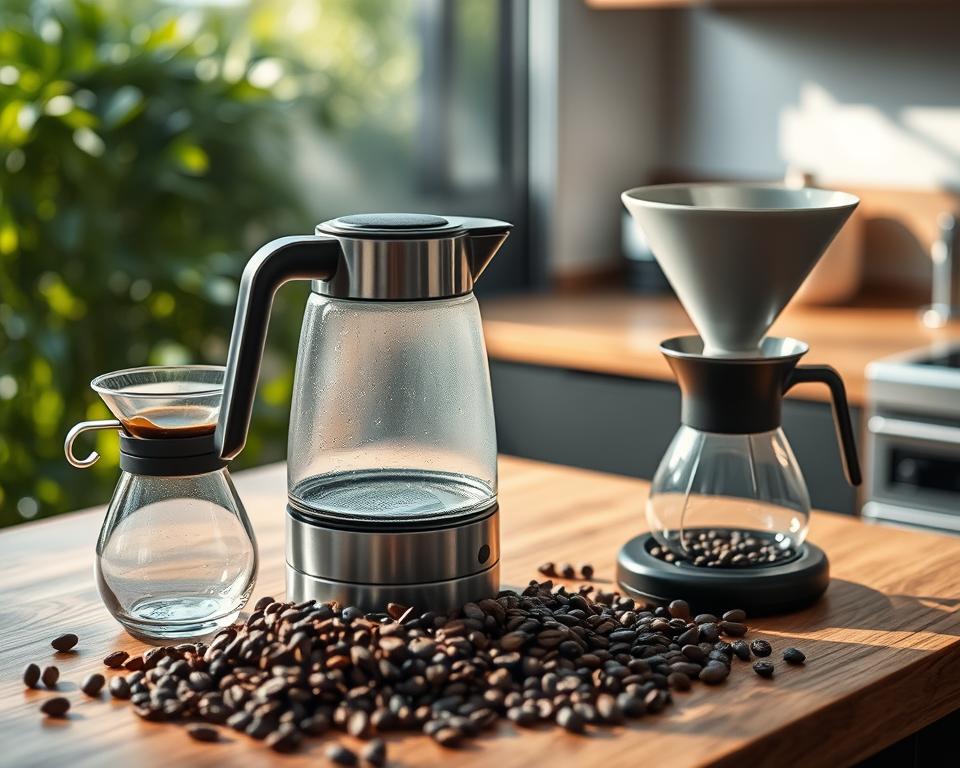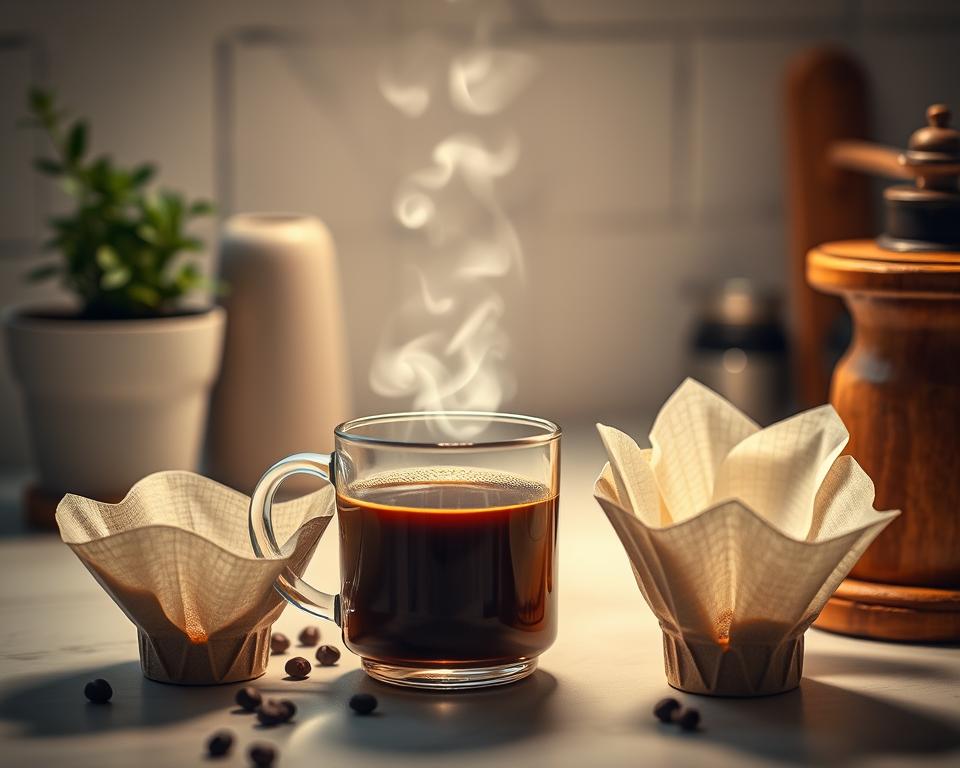Each filter affects the coffee’s story, from its origin to its roast. Exploring coffee filter brands shows us the variety available.
This variety can change your morning coffee from good to exceptional.
Key Takeaways
- Discover the historical significance and present-day versatility of various coffee filter types.
- Learn how coffee filter material influences the flavour profile—from “clean” and “bright” to full-bodied.
- Understand the importance of selecting the right coffee filter sizes for optimal brewing.
- Appreciate the environmental considerations in choosing between disposable and reusable coffee filters.
- Explore the unique shapes of coffee filters and their compatibility with different coffee brewers.
Understanding the Basics of Coffee Filter Materials
When I think about making the perfect morning cup, the type of coffee filter really matters. It affects our taste and our planet. We have three main types: paper, metal, and cloth.
Each one offers different benefits, from easy-to-throw-away paper filters to reusable metal ones.
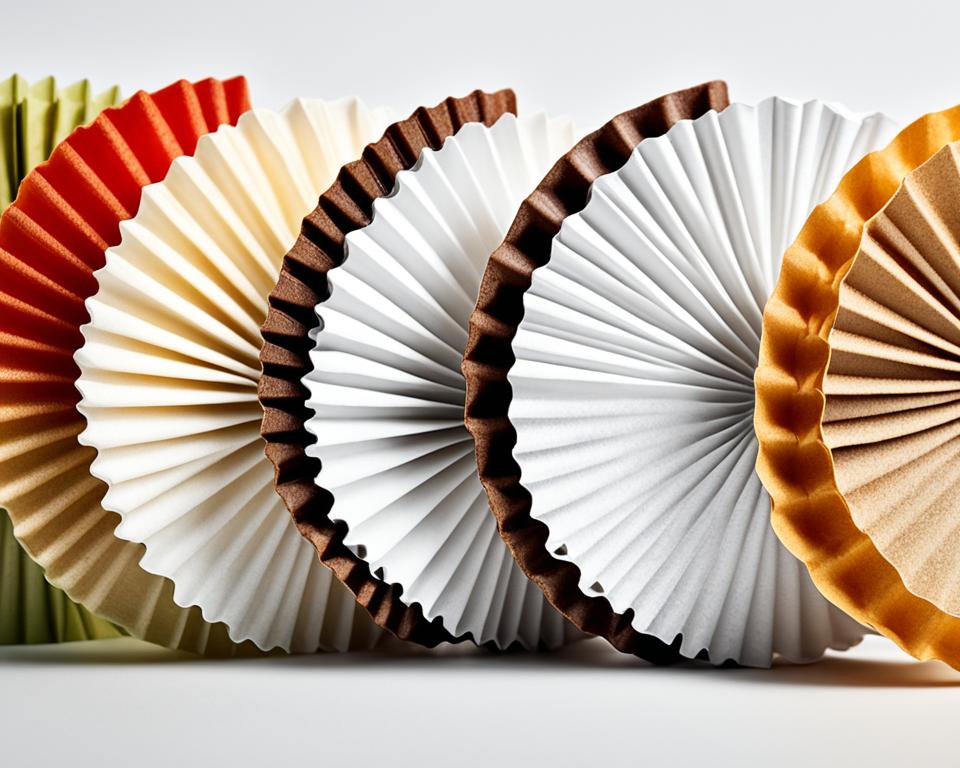
Paper Coffee Filters: Brighter Brews with Easy Cleanup
Paper filters are common and help make cleaner coffee by trapping oils and tiny grounds. But using lots of paper filters can hurt the environment. This is especially true for ones treated with chlorine.
- Paper filters capture oils and micro-grounds for a clean taste.
- Environmental considerations with disposable filter waste.
- Options like Melitta’s inclusion of bamboo are a step towards sustainability.
Metal Coffee Filters: Fuller Flavors with More Body
Metal coffee filters are strong and bring out more taste. They let the coffee’s natural oils and fine bits mix in the cup. Since they last a long time, they’re good for the planet. Despite costing more at first, they save money and resources in the long run.
- Allow more oils and fines for a richer cup.
- Durable, with a lifespan reducing filter waste.
- Gold-plated filters add a touch of luxury to the sustainable choice.
Cloth Coffee Filters: The Reusable Medium
Cloth filters, like those from hemp, find a sweet spot in coffee making. They catch the grounds but let some oils through. However, they need to be replaced more often, about every 4 to 6 months.
Despite the extra effort to keep them clean, they offer a great reusable option.
| Filter Type | Lifespan | Sustainability Factor | Taste Impact |
|---|---|---|---|
| Paper Coffee Filters | Single-use | Biodegradable options are available, though energy-intensive to produce | Brighter brews with high clarity |
| Metal Coffee Filters | Up to 10 years | Reduce continual waste and the small environmental impact of gold mining | Fuller flavor with more body |
| Cloth Coffee Filters | 4-6 months | Less waste than paper, but frequent washing is required | Balanced flavor, fuller than paper but cleaner than metal |
Choosing a coffee filter isn’t just about the material. The size of the filter matters too. It changes how we use our coffee makers. Whether it’s a Melitta filter or a Hario cone, making coffee is a personal touch in our morning routine.
Coffee Filter Types: Deciding Between Paper, Metal, and Cloth
When deciding on coffee filter types, think about the flavour you like. Also, think about money and environmental impact. Paper, metal, and cloth filters have their own pros and cons.
Paper filters are cheap, costing just a cent each. But using them every day can cost up to $36.50 a year. They’re easy to use; just throw them away after brewing. But they create more trash, which is bad for the planet.
Metal filters cost more, between $5 and $60, but they last for years. They can save money over time compared to paper filters. They’re better for the environment, too. But metal filters need more cleaning and might clog your sink.
- Metal filters give a strong taste because they let oils into your coffee. But they might raise your cholesterol.
- Paper filters make your coffee taste brighter and sweeter. They’re easy to use and clean.
- Cloth filters are in between, offering a tasty coffee with less trash. But they need more effort to clean.
Brand quality varies for paper vs. metal coffee filters. Some love the clean taste of paper-filtered coffee. Others prefer the deep taste of metal filters. Cloth filters, though not as popular, also offer good taste and are eco-friendly.
| Filter Type | Initial Cost | Annual Cost* | Taste Profile | Environmental Impact | Cleanup Time |
|---|---|---|---|---|---|
| Paper | $0.01 to $0.10 each | $18.25 – $36.50 | Bright and sweet | High waste | Minimal |
| Metal | $5 to $60 | $8.57 – $60 per year | Rich and heavy | Zero waste | 30 to 60 seconds |
| Cloth | Varies | Minimal cost (reusable) | Aromatic and medium-bodied | Minimal waste | 30 to 60 seconds |
Costs are calculated based on one cup per day of usage.
Choosing Coffee Filter Types means balancing taste, cost, cleanup, and eco-friendly practices. The right filter makes your coffee better suited to your taste and lifestyle.
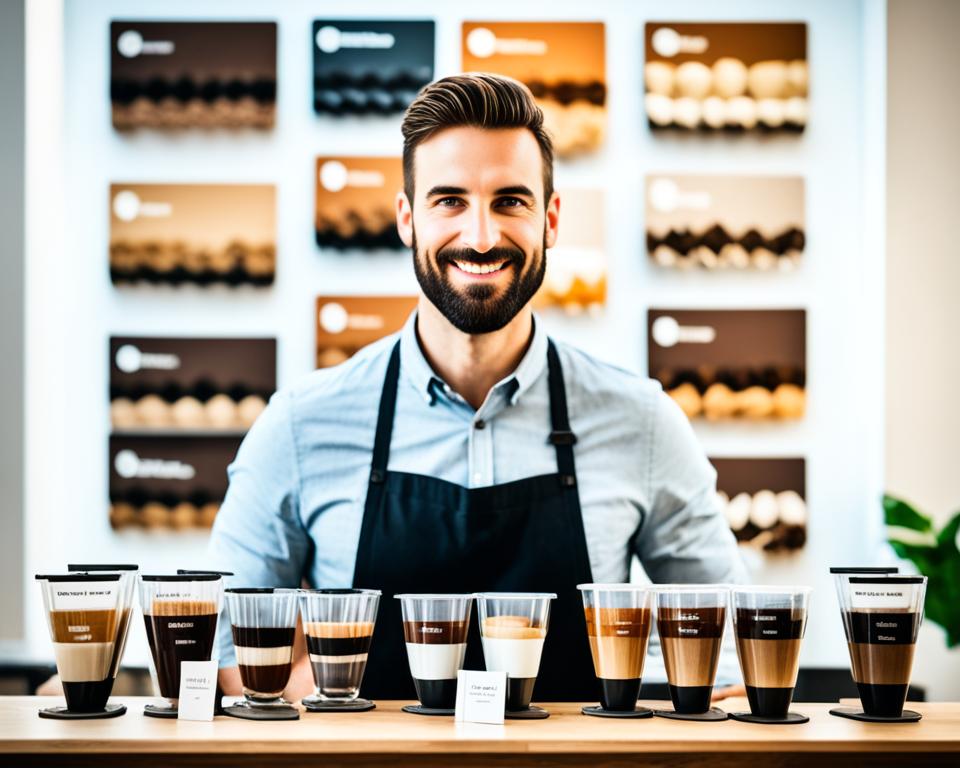
The Impact of Coffee Filter Shapes on Your Daily Cup
As a coffee lover, I always look into what makes my morning brew special. Today, we’re talking about cone vs. basket coffee filters. These choices are as vital as the coffee beans themselves.
The design of cone-shaped coffee filters and flat-bottom coffee filters adds to their unique tastes. They can turn your coffee game into an art.
Cone vs. Basket Coffee Filters: A Brewing Showdown
Cone filters, like those for the Hario V60, focus water at one point. This method pulls out the best in lighter roasts, making citrus and berry notes pop. It creates a distinctive tasting experience.
On the flip side, basket-shaped coffee filters for the Kalita Wave spread water evenly. This method highlights the sweetness and floral notes in my beans. It produces a well-rounded flavour that I love.
Flat-Bottom Filters: The Key to an Even Extraction?
Don’t overlook flat-bottom or basket filters; many people prefer them. They make brewing easy and consistent, which is perfect for those seeking great taste without hassle.
The outcome? A brew that’s rich, comforting, and full of sweet and woody notes. It’s especially delicious with dark roasts.
Specialty Shape Filters: When Unique Brewing Calls
Certain gadgets in my arsenal, like the Aeropress, need specific filters. The compact disc-shaped filters stop grounds from leaking. They ensure a smooth, delicious cup.
These custom coffee filters are vital for top-notch results. They show how crucial specialty-shaped coffee filters are for brewing adventures.
I’m always excited by how much filter shapes affect my coffee routine. The right filter, whether I want a bright cup or a deep brew, is key. It’s clear that filters like the cone, basket, and others are not just add-ons.
They’re essential for making the perfect coffee every morning.
Coffee Filter Types: Selecting the Right Coffee Filter Size for Your Brewer
Finding the right coffee filter is all about the details. The Kalita Wave 185 Dripper stands out for pour-over fans. Experts like Tony “Tonx” Konecny have praised it. They say it makes smooth and flavorful coffee. But finding the right filters can be tough.
Understanding coffee filter sizes is key. Sizes like #1, #2, #4, and #6 should fit your brewer perfectly. The right filter does more than just fit. It improves the brewing to give you a better cup every time.
Compatibility Tip:
For the best experience, use filters that fit your coffee brewer exactly.
Navigating Standard Filter Sizes: #1, #2, #4, and #6
The Hario V-60 Coffee Dripper needs a size 02 paper filter. This shows the importance of matching filter sizes with your brewing method. These standard sizes are easy to find and mainly paper.
They help make a clean and clear brew.
Device-Specific Filters: Tailored Fit for Optimal Brewing
Looking for the perfect fit in coffee filters can take you to brand-specific ones. This is true if you have a Mr. Coffee or Moccamaster. The right filter not only fits but also enhances your coffee machine’s features.
Reusable Filters: Sustainability Meets Convenience
Permanent filters, often metal, are becoming popular for eco-friendly brewing. These filters let more oils through, making richer coffee. Using metal or cloth filters is better for the planet. They can be used again and reduce waste.
Pro Tip: No filters? A paper towel or cloth dish towel can be a quick fix.
Choosing the right filter size is about matching your coffee maker with its best partner. Whether paper or reusable, focusing on sustainability is important. It makes our coffee rituals better for us and the earth.
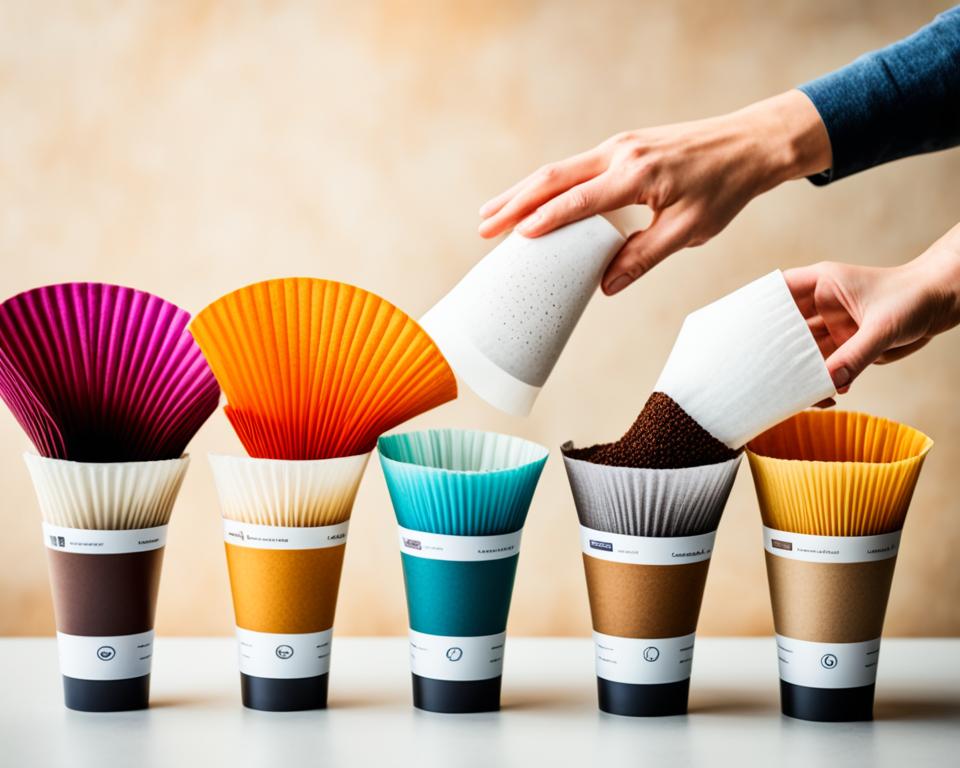
| Coffee Dripper | Filter Size | Type of Filter | Cost | Sustainability |
|---|---|---|---|---|
| Kalita Wave 185 | Proprietary Wave | Wavy Paper | Higher | Low |
| Hario V-60 (Size 02) | Size 02 | Standard Cone | Medium | Low |
| Universal Reusable | Various | Metal / Cloth | One-time investment | High |
For coffee enthusiasts, choosing the right filter ties great taste with eco-awareness. Whether it’s paper, wavy, or reusable, picking the right size is about enjoying fine coffee and taking care of our planet.
How Do Different Coffee Types Affect the Choice of Coffee Filter for Better Brews?
When exploring coffee varieties, the choice of coffee filter plays a crucial role in achieving the perfect brew. For instance, a pour-over method works wonders with light roasts, allowing subtle flavors to shine through. In contrast, a French press paired with a coarse filter enhances the bold, rich profiles of dark blends.
Coffee Filter Types: Conclusion
Searching for the perfect coffee is a journey I love deeply. With people all over the world drinking over 400 billion cups a year, my choice of coffee filters feels very personal.
Choosing between paper, metal, or cloth filters affects the taste of my coffee in significant ways. This coffee filter guide has really helped me and other coffee lovers find the right filter for their tastes.
Choosing the right filter is not just about taste. It’s also about being kind to the environment. Learning how filters affect flavour and the environment has made me choose eco-friendly options. I now rinse my filters before use.
This simple step makes my coffee taste better and helps the planet too.
For me, making coffee is also about being eco-friendly. That’s why I keep my filters away from strong smells and choose reliable brands. I always look for coffee filters that match my needs perfectly in shape, size, and material.
To me, a cup of coffee is more than just a drink. It reflects my tastes, shows my environmental choices, and brings joy with every sip.
FAQ
What are the different types of coffee filters?
You can choose from paper, metal, and cloth coffee filters. Paper ones are throw-away, while metal ones are often stainless steel and can be reused. Cloth filters are also reusable and give coffee a unique taste.
How do the materials of coffee filters affect the taste of coffee?
Each material changes how your coffee tastes. Paper filters catch oils and fine grounds, making the coffee less oily with a clear acidity. Metal filters let more oils through, which gives your coffee a richer taste. Cloth filters are in the middle; they let some oil through but keep grounds out.
What are the differences between cone and basket coffee filters?
Cone filters direct water in a way that pulls out specific flavours from the coffee. Basket filters spread the water more evenly. This might make the coffee taste better to some people.
Why might I choose paper over metal coffee filters, or vice versa?
Your choice depends on taste and if you’re thinking about the planet. Paper filters make a less oily cup and are simple to throw away. Metal filters last longer and make a richer brew, but they need cleaning.
What do the numbers on paper coffee filters mean?
Numbers like #1, #2, #4, and #6 tell you the filter’s size. This affects how much coffee they can filter. Bigger numbers mean more coffee can be brewed.
Are there coffee filters designed for specific brewing devices?
Yes, some coffee makers need special filters to work properly. For example, Aeropress uses disc-shaped filters. It’s best to use the matching filter shape to get great coffee.
How do I know which size filter to use with my coffee maker?
Look at the recommendation from your coffee maker’s brand for the right size. The right filter gives you a great brew.
What are some reputable coffee filter brands?
Well-known brands include Chemex and Melitta for paper filters. For metal, try Able Brewing or Kaffeologie. AeroPress is famous for its unique paper filters.
Can reusable coffee filters save money and reduce waste?
Yes, metal or cloth filters are good for both your wallet and the planet. They need more cleaning but can cut down on paper waste.
Are there any cloth vs. paper coffee filter considerations?
Think about taste, how much cleaning you’re okay with, and the environment. Cloth filters are greener but need regular cleaning to avoid taste changes.
What influences coffee filter compatibility?
The filter must fit the shape and size of your coffee maker. This ensures evenly distributed water and the best flavour.
Is there a difference in flavour between bleached and unbleached paper coffee filters?
Unbleached filters might change the taste slightly, but rinsing them first helps. Bleached filters don’t affect taste but aren’t great for the environment.
How do flat-bottom filters contribute to even coffee extraction?
Flat-bottom filters spread water nicely over the coffee. This makes your coffee taste consistently good every time.
Are there eco-friendly coffee filters available?
Yes, you can find metal and cloth filters that are reusable. Some paper filters are also eco-friendly if they’re compostable and made without bleach.

